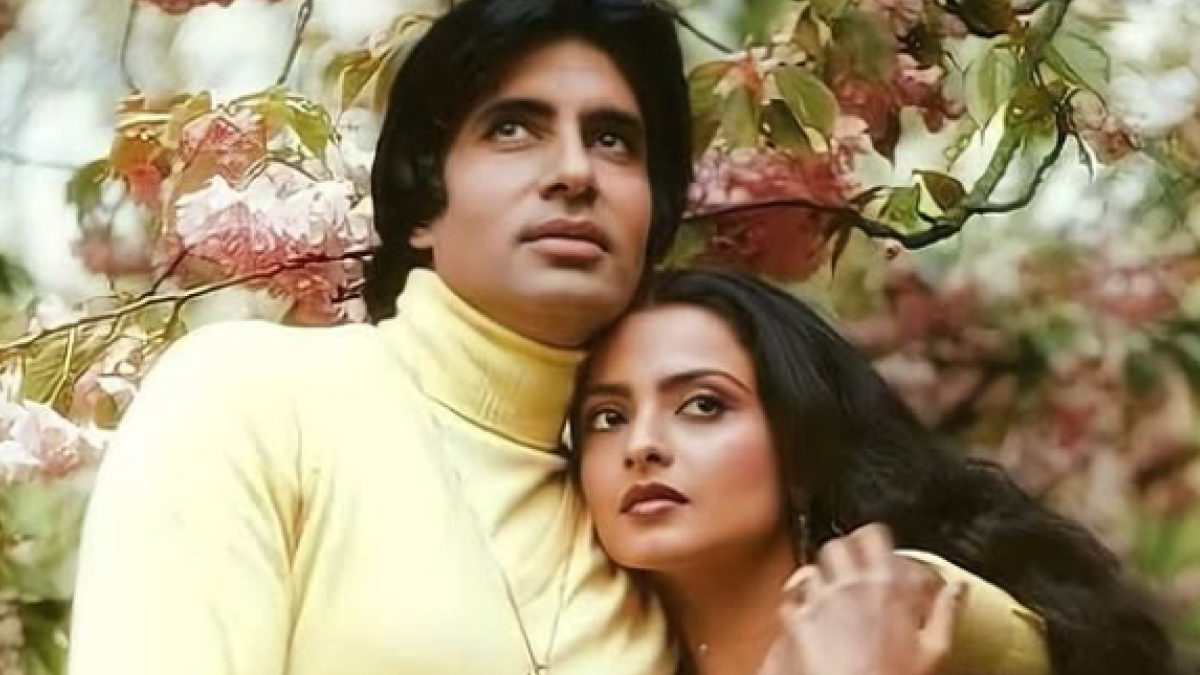Before Yash Chopra dared audiences with Lamhe in 1991 — a love story that challenged morality and age — he had already taken an even greater leap a decade earlier. In 1981, Silsila blurred the boundaries between reel and real, turning the personal lives of its stars into the most talked-about story in Indian cinema.
It wasn’t just a film about forbidden love — it was the film that embodied it.
By the late 1970s, Amitabh Bachchan had risen to superstardom. His marriage to Jaya Bhaduri in 1973 — after their success in Zanjeer — was celebrated across the country. Together, they symbolized stability, intellect, and domestic grace — the first couple of Hindi cinema’s new middle-class dream.
And then, there was Rekha.
Rekha and Amitabh’s on-screen chemistry — in Do Anjaane, Mr. Natwarlal, Muqaddar Ka Sikandar, and Khoon Pasina — was electric, undeniable, and, soon, impossible to separate from rumour. The tabloids of the late ’70s thrived on whispers of an affair that neither actor confirmed, yet neither convincingly denied.
When Yash Chopra announced Silsila, the shockwaves were immediate. The cast — Amitabh Bachchan, Jaya Bachchan, and Rekha — was more than just daring. It was incendiary. It felt like the entire nation’s gossip columns had been turned into a screenplay.
Chopra was no stranger to risk, but Silsila tested even his nerves. The film followed Amit (Bachchan), who, after marrying Shobha (Jaya), finds himself emotionally drawn to his former lover Chandni (Rekha). What unfolded on screen mirrored the public imagination of what was unfolding off it.
In a later BBC interview Yash Chopra admitted just how volatile the atmosphere was, “I was always on tenterhooks and scared because it was real life coming into reel life. Jaya is his wife and Rekha is his girlfriend — same story is going on. Anything could have happened because they were working together.”
The decision to cast them wasn’t a stunt — it was a creative conviction. Chopra believed that truth, however uncomfortable, gives cinema its pulse. Convincing Jaya Bachchan to return to films after marriage was itself an emotional gamble. She had largely stepped back from acting to raise her children, but Chopra and Amitabh persuaded her. Industry observers say she agreed partly out of professional grace, and partly, perhaps, to confront the narrative head-on.
Rekha, on the other hand, arrived on set with remarkable composure. Years later, she recalled shooting an emotional scene amid thousands of onlookers, “Surrounded by 15,000 people, I felt overwhelmed by the pressure to deliver emotionally charged lines. Despite the chaos, the scene became one of the film’s most iconic.” Rekha, recalling the shoot in a moneycontrol story.
Yash Chopra described the set as “a powder keg of emotion.” Every glance, every silence carried a weight that no direction could script. “It was like walking on a tightrope every day. But perhaps that is why the emotions on screen still resonate — they were real,” recalled Yash Chopra in a TOI article.
When Silsila released in August 1981, it didn’t set the box office ablaze. Audiences admired its craft but hesitated at its truth. The film was elegant, restrained — and uncomfortably close to real life. Critics called it bold but unsettling; viewers were torn between empathy and voyeurism.
Yet, even those who struggled with its narrative couldn’t ignore its music. With songs composed by Shiv-Hari and lyrics by Javed Akhtar, Silsila carried Yash Chopra’s unmistakable gift for melody and emotion. Tracks like “Dekha Ek Khwab”, “Yeh Kahaan Aa Gaye Hum”, and “Neela Aasman So Gaya” weren’t just romantic interludes — they became emotional signatures of the film, reflecting its unspoken ache. Chopra’s instinct for blending poetry with visual rhythm ensured that, long after the controversy faded, Silsila’s music continued to live on airwaves and in memory.
But one thing was certain — it was the last time Amitabh Bachchan and Rekha ever appeared together on screen. Their silences in the years that followed only deepened the mystique.
Jaya Bachchan would later address the rumours with characteristic dignity, “If there was any [affair], he would have been somewhere else, na? People liked them as a couple on screen, and that’s fine. The media tried linking him with every one of his heroines. My life would have been hell if I had taken it all seriously,” expressed Jaya Bachchan in an IE story .
Also Read: Amitabh Bachchan’s 83rd Birthday: A Celebration Like No Other, Here’s How!
A decade later, Chopra would again explore the boundaries of love with Lamhe — another story that defied societal comfort. If Silsila questioned fidelity, Lamhe questioned age and emotional propriety. Both films were misunderstood in their time; both have since been re-evaluated as masterworks.
In hindsight, Silsila wasn’t just a love story — it was Yash Chopra’s first confrontation with moral fear, a filmmaker’s declaration that emotion cannot be sanitized. It laid the foundation for the kind of honesty that Lamhe would later perfect.
From Silsila to Lamhe, Yash Chopra consistently challenged the emotional conservatism of his audience. He believed love wasn’t about perfection — it was about contradiction, sacrifice, and truth.
And that’s why, even decades later, Silsila continues to fascinate — not as gossip, but as cinema’s most daring intersection of art and life.
It wasn’t merely a story Yash Chopra told.
It was one he risked living.

